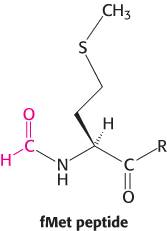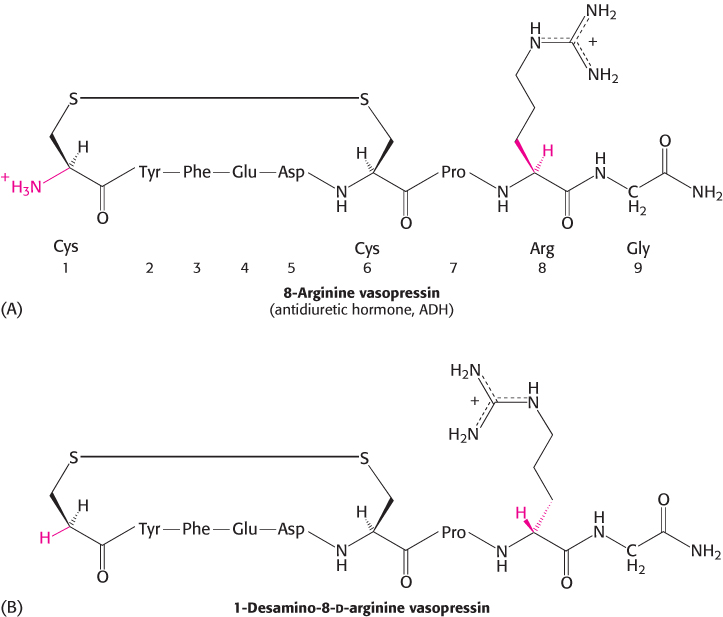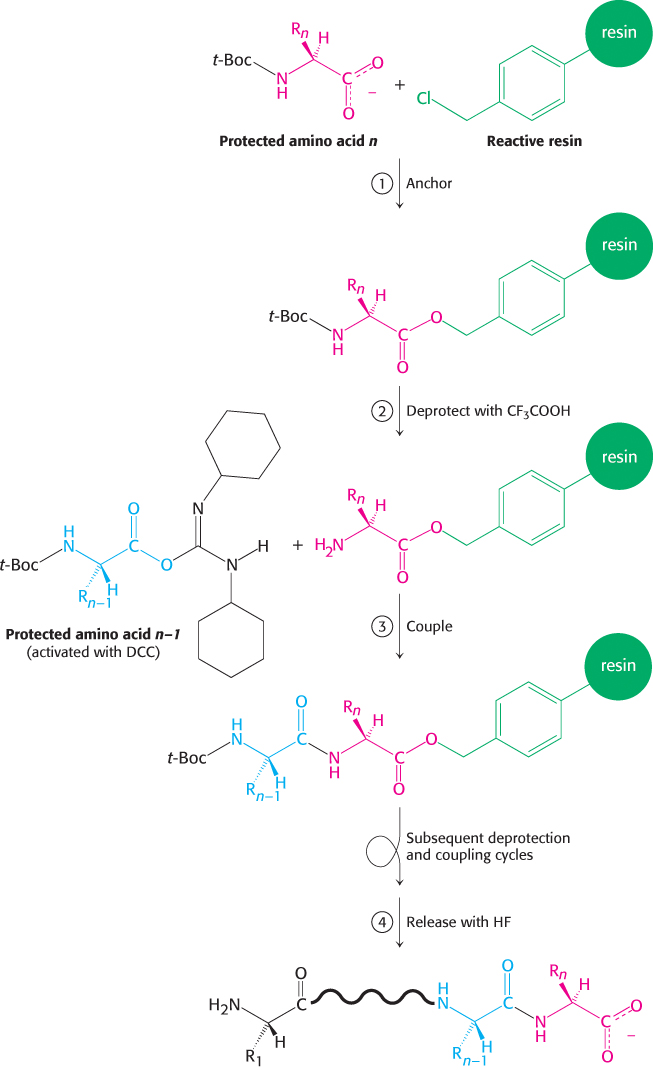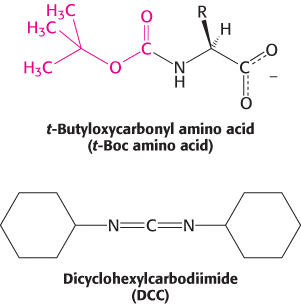3.4 Peptides Can Be Synthesized by Automated Solid-Phase Methods
Peptides of defined sequence can be synthesized to assist in biochemical analysis. These peptides are valuable tools for several purposes.
1. Synthetic peptides can serve as antigens to stimulate the formation of specific antibodies. Suppose we want to isolate the protein expressed by a specific gene. Peptides can be synthesized that match the translation of part of the gene’s nucleic acid sequence, and antibodies can be generated that target these peptides. These antibodies can then be used to isolate the intact protein or localize it within the cell.
2. Synthetic peptides can be used to isolate receptors for many hormones and other signal molecules. For example, white blood cells are attracted to bacteria by formylmethionyl (fMet) peptides released in the breakdown of bacterial proteins. Synthetic formylmethionyl peptides have been useful in identifying the cell-surface receptor for this class of peptide. Moreover, synthetic peptides can be attached to agarose beads to prepare affinity chromatography columns for the purification of receptor proteins that specifically recognize the peptides.

 3. Synthetic peptides can serve as drugs. Vasopressin is a peptide hormone that stimulates the reabsorption of water in the distal tubules of the kidney, leading to the formation of more-concentrated urine. Patients with diabetes insipidus are deficient in vasopressin (also called antidiuretic hormone), and so they excrete large volumes of dilute urine (more than 5 liters per day) and are continually thirsty. This defect can be treated by administering 1-desamino-8-d-arginine vasopressin, a synthetic analog of the missing hormone (Figure 3.36). This synthetic peptide is degraded in vivo much more slowly than vasopressin and does not increase blood pressure.
3. Synthetic peptides can serve as drugs. Vasopressin is a peptide hormone that stimulates the reabsorption of water in the distal tubules of the kidney, leading to the formation of more-concentrated urine. Patients with diabetes insipidus are deficient in vasopressin (also called antidiuretic hormone), and so they excrete large volumes of dilute urine (more than 5 liters per day) and are continually thirsty. This defect can be treated by administering 1-desamino-8-d-arginine vasopressin, a synthetic analog of the missing hormone (Figure 3.36). This synthetic peptide is degraded in vivo much more slowly than vasopressin and does not increase blood pressure.

Figure 3.36: Vasopressin and a synthetic vasopressin analog. Structural formulas of (A) vasopressin, a peptide hormone that stimulates water resorption, and (B) 1-desamino-8-d-arginine vasopressin, a more stable synthetic analog of this antidiuretic hormone.
4. Finally, studying synthetic peptides can help define the rules governing the three-dimensional structure of proteins. We can ask whether a particular sequence by itself tends to fold into an α helix, a β strand, or a hairpin turn or behaves as a random coil. The peptides created for such studies can incorporate amino acids not normally found in proteins, allowing more variation in chemical structure than is possible with the use of only 20 amino acids.
How are these peptides constructed? The amino group of one amino acid is linked to the carboxyl group of another. However, a unique product is formed only if a single amino group and a single carboxyl group are available for reaction. Therefore, it is necessary to block some groups and to activate others to prevent unwanted reactions. First, the carboxyl-terminal amino acid is attached to an insoluble resin by its carboxyl group, effectively protecting it from further peptide-bond-forming reactions (Figure 3.37). The α-amino group of this amino acid is blocked with a protecting group such as a tert-butyloxycarbonyl (t-Boc) group. The t-Boc protecting group of this amino acid is then removed with trifluoroacetic acid.

Figure 3.37: Solid-phase peptide synthesis. The sequence of steps in solid-phase synthesis is: (1) anchoring of the C-terminal amino acid to a solid resin, (2) deprotection of the amino terminus, and (3) coupling of the free amino terminus with the DCC-activated carboxyl group of the next amino acid. Steps 2 and 3 are repeated for each added amino acid. Finally, in step 4, the completed peptide is released from the resin.

The next amino acid (in the protected t-Boc form) and dicyclohexylcarbodiimide (DCC) are added together. At this stage, only the carboxyl group of the incoming amino acid and the amino group of the resin-bound amino acid are free to form a peptide bond. DCC reacts with the carboxyl group of the incoming amino acid, activating it for the peptide-bond-forming reaction. After the peptide bond has formed, excess reagents are washed away, leaving the desired dipeptide product attached to the beads. Additional amino acids are linked by the same sequence of reactions. At the end of the synthesis, the peptide is released from the beads by the addition of hydrofluoric acid (HF), which cleaves the carboxyl ester anchor without disrupting peptide bonds. Protecting groups on potentially reactive side chains, such as that of lysine, also are removed at this time.
A major advantage of this solid-phase method, first developed by R. Bruce Merrifield, is that the desired product at each stage is bound to beads that can be rapidly filtered and washed. Hence, there is no need to purify intermediates. All reactions are carried out in a single vessel, eliminating losses caused by repeated transfers of products. This cycle of reactions can be readily automated, which makes it feasible to routinely synthesize peptides containing about 50 residues in good yield and purity. In fact, the solid-phase method has been used to synthesize interferons (155 residues) that have antiviral activity and ribonuclease (124 residues) that is catalytically active. The protecting groups and cleavage agents may be varied for increased flexibility or convenience.
Synthetic peptides can be linked to create even longer molecules. With the use of specially developed peptide-ligation methods, proteins of 100 amino acids or more can by synthesized in very pure form. These methods enable the construction of even sharper tools for examining protein structure and function.

 3. Synthetic peptides can serve as drugs. Vasopressin is a peptide hormone that stimulates the reabsorption of water in the distal tubules of the kidney, leading to the formation of more-
3. Synthetic peptides can serve as drugs. Vasopressin is a peptide hormone that stimulates the reabsorption of water in the distal tubules of the kidney, leading to the formation of more-

